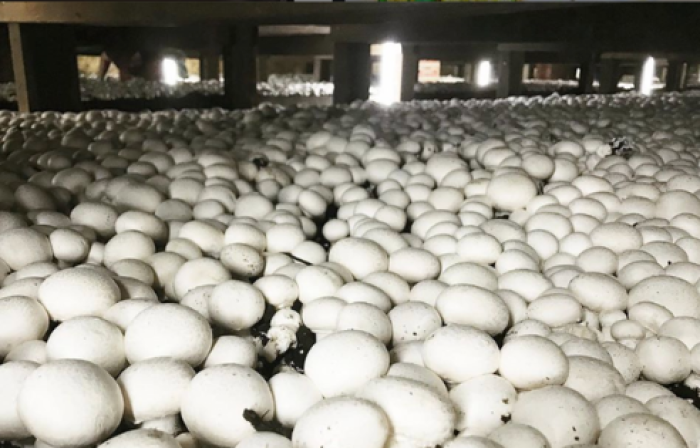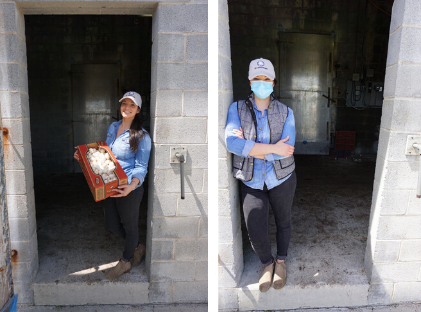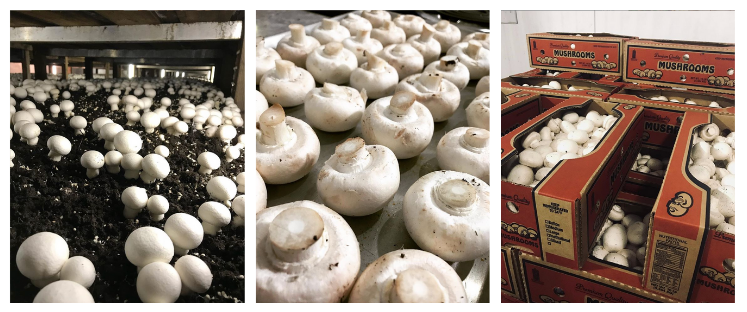Articles
Learn How Mushrooms Are Grown From Someone Who Grows Them

Mushrooms may accompany other fruits and veggies in the produce aisle, but they’re grown very differently than other plants we eat. There are no fields or forests. No tilling of soil or sowing of seeds. Sunshine isn’t even necessary to grow the nutritious fungi.
Instead, rows and stacks of mushroom-growing beds are lined up in large climate-controlled buildings. They’re kept indoors so they can be grown year-round in optimal environmental conditions. To learn more about the intricacies of growing high-quality mushrooms, we chatted with someone who grows them herself.
Sonya Beltran grows white mushrooms with her family at First Generation Farms in southeastern Pennsylvania. Her dad got started in the industry almost 40 years ago, so she grew up around mushroom farming. Later in life, she joined him at the family business and is now the director of operations. Sonya, along with her dad, mom and best friend, oversee the farm’s operations, while about 70 team members help them care for and harvest mushrooms.

“I enjoy telling people how mushrooms are grown,” said Sonya. “When people think of mushrooms, they typically think of foraging in forests, but that’s not the reality in conventional mushroom farming. Mushrooms require a very specific climate so growing them in houses where temperature and moisture can be regulated is much more efficient. People are always surprised to know the huge buildings they’ve been driving past for years are filled to the ceiling with beds of fresh mushrooms.”
So, if they don’t drive tractors across farm fields, what do mushroom farmers do? Here’s what a typical day looks like for Sonya:
- Check in at the office and attend to administrative needs.
- Prepare food safety training for team members.
- Check in with supervisors at the farm.
- Walk through mushroom houses with her dad to check product quality, harvesting procedures and climate conditions of growing rooms.
“My dad spends most of his time at the farm, and my mom works in the office. I go back and forth between both,” shared Sonya. “One of my best friends works in the office too, but it’s really just us who run the business. We also have a really great team that helps at the farm. Most of our supervisors are family or people we’ve known for a really long time who have become like family.”
It takes a team to grow high-quality mushrooms and fulfill customer orders. Here’s what the growing process looks like at First Generation Farms:
- Preparing the Compost: Compost is purchased and then pasteurized at 145 F to kill any pests and fungus, and help reduce ammonia. The pasteurized compost is then lowered to 90 F and prepared for spawning.
- Spawning: Spawn, which is kind of like mushrooms' version of seeds, gets mixed in with the compost. Beds are then filled with the spawn-compost mixture.
- Casing: After 14-21 days, casing, which consists of peat moss and lime, gets put on top of the compost. It acts like fertilizer and a water reservoir for the spawn underneath.
- Watering: Each house is checked every day and water is applied as needed based on the condition of each bed.
- Pinning: Mushrooms begin to grow above the surface and fresh air is introduced into the house to reduce carbon dioxide levels. In 16-18 days, mushrooms are ready to harvest.
- Harvesting: The first round of mushrooms is carefully harvest, packed and sent to customers. Multiple "breaks" of mushrooms can be harvested every three to five days from the same spawn. Growers watch mushroom size and quality to decide when to start the process over again with fresh spawn and compost.
- Clean Out: House are emptied, cleaned and prepared for growing the next crop.
The growing process takes about 55 days from when houses are filled to harvest. Throughout the process, cleanliness and consistency are key.

“Cleanliness is really important to us because it directly affects mushroom quality and food safety,” explained Sonya. “Our team members use gloves, wash their hands regularly and wear hair nets when harvesting. Proper handling is also important because mushrooms bruise easily, and we don’t want them showing up that way for our customers.”
Although Sonya grew up the daughter of a mushroom farmer, she wasn’t always active in the family business.
“When I first started, I didn’t understand the concept of having a farm,” said Sonya. “I worked in retail for many years but being in the mushroom industry, seeing the whole process and understanding the importance of food safety made me realize how important it is to know where your food comes from. It’s really made me appreciate being able to grow my own produce.”
Learn more about what makes mushrooms one of the most sustainably produced foods in the U.S. thanks to farmers like Sonya and then get to cooking with your favorite variety!





